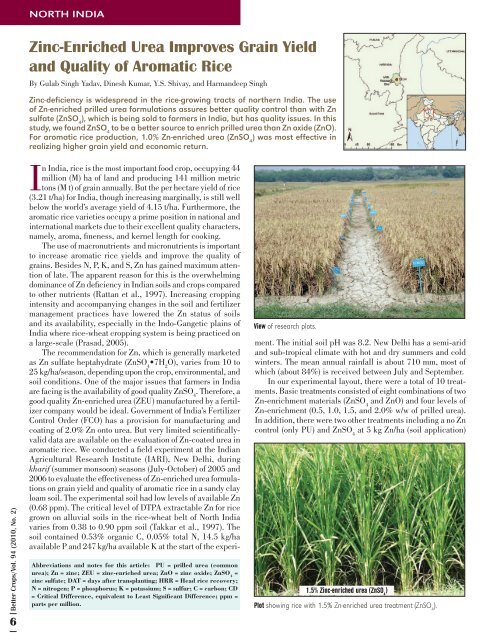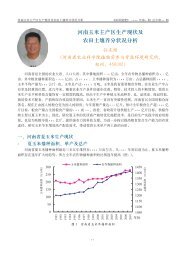Zinc-Enriched Urea Improves Grain Yield and Quality of Aromatic Rice
Zinc-Enriched Urea Improves Grain Yield and Quality of Aromatic Rice
Zinc-Enriched Urea Improves Grain Yield and Quality of Aromatic Rice
You also want an ePaper? Increase the reach of your titles
YUMPU automatically turns print PDFs into web optimized ePapers that Google loves.
Better Crops/Vol. 94 (2010, No. 2)<br />
6<br />
North INDIA<br />
<strong>Zinc</strong>-<strong>Enriched</strong> <strong>Urea</strong> <strong>Improves</strong> <strong>Grain</strong> <strong>Yield</strong><br />
<strong>and</strong> <strong>Quality</strong> <strong>of</strong> <strong>Aromatic</strong> <strong>Rice</strong><br />
By Gulab Singh Yadav, Dinesh Kumar, Y.S. Shivay, <strong>and</strong> Harm<strong>and</strong>eep Singh<br />
<strong>Zinc</strong>-deficiency is widespread in the rice-growing tracts <strong>of</strong> northern India. The use<br />
<strong>of</strong> Zn-enriched prilled urea formulations assures better quality control than with Zn<br />
sulfate (ZnSO 4 ), which is being sold to farmers in India, but has quality issues. In this<br />
study, we found ZnSO 4 to be a better source to enrich prilled urea than Zn oxide (ZnO).<br />
For aromatic rice production, 1.0% Zn-enriched urea (ZnSO 4 ) was most effective in<br />
realizing higher grain yield <strong>and</strong> economic return.<br />
In India, rice is the most important food crop, occupying 44<br />
million (M) ha <strong>of</strong> l<strong>and</strong> <strong>and</strong> producing 141 million metric<br />
tons (M t) <strong>of</strong> grain annually. But the per hectare yield <strong>of</strong> rice<br />
(3.21 t/ha) for India, though increasing marginally, is still well<br />
below the world’s average yield <strong>of</strong> 4.15 t/ha. Furthermore, the<br />
aromatic rice varieties occupy a prime position in national <strong>and</strong><br />
international markets due to their excellent quality characters,<br />
namely, aroma, fineness, <strong>and</strong> kernel length for cooking.<br />
The use <strong>of</strong> macronutrients <strong>and</strong> micronutrients is important<br />
to increase aromatic rice yields <strong>and</strong> improve the quality <strong>of</strong><br />
grains. Besides N, P, K, <strong>and</strong> S, Zn has gained maximum attention<br />
<strong>of</strong> late. The apparent reason for this is the overwhelming<br />
dominance <strong>of</strong> Zn deficiency in Indian soils <strong>and</strong> crops compared<br />
to other nutrients (Rattan et al., 1997). Increasing cropping<br />
intensity <strong>and</strong> accompanying changes in the soil <strong>and</strong> fertilizer<br />
management practices have lowered the Zn status <strong>of</strong> soils<br />
<strong>and</strong> its availability, especially in the Indo-Gangetic plains <strong>of</strong><br />
India where rice-wheat cropping system is being practiced on<br />
a large-scale (Prasad, 2005).<br />
The recommendation for Zn, which is generally marketed<br />
as Zn sulfate heptahydrate (ZnSO 4 •7H 2 O), varies from 10 to<br />
25 kg/ha/season, depending upon the crop, environmental, <strong>and</strong><br />
soil conditions. One <strong>of</strong> the major issues that farmers in India<br />
are facing is the availability <strong>of</strong> good quality ZnSO 4 . Therefore, a<br />
good quality Zn-enriched urea (ZEU) manufactured by a fertilizer<br />
company would be ideal. Government <strong>of</strong> India’s Fertilizer<br />
Control Order (FCO) has a provision for manufacturing <strong>and</strong><br />
coating <strong>of</strong> 2.0% Zn onto urea. But very limited scientificallyvalid<br />
data are available on the evaluation <strong>of</strong> Zn-coated urea in<br />
aromatic rice. We conducted a field experiment at the Indian<br />
Agricultural Research Institute (IARI), New Delhi, during<br />
kharif (summer monsoon) seasons (July-October) <strong>of</strong> 2005 <strong>and</strong><br />
2006 to evaluate the effectiveness <strong>of</strong> Zn-enriched urea formulations<br />
on grain yield <strong>and</strong> quality <strong>of</strong> aromatic rice in a s<strong>and</strong>y clay<br />
loam soil. The experimental soil had low levels <strong>of</strong> available Zn<br />
(0.68 ppm). The critical level <strong>of</strong> DTPA extractable Zn for rice<br />
grown on alluvial soils in the rice-wheat belt <strong>of</strong> North India<br />
varies from 0.38 to 0.90 ppm soil (Takkar et al., 1997). The<br />
soil contained 0.53% organic C, 0.05% total N, 14.5 kg/ha<br />
available P <strong>and</strong> 247 kg/ha available K at the start <strong>of</strong> the experi-<br />
Abbreviations <strong>and</strong> notes for this article: PU = prilled urea (common<br />
urea); Zn = zinc; ZEU = zinc-enriched urea; ZnO = zinc oxide; ZnSO 4 =<br />
zinc sulfate; DAT = days after transplanting; HRR = Head rice recovery;<br />
N = nitrogen; P = phosphorus; K = potassium; S = sulfur; C = carbon; CD<br />
= Critical Difference, equivalent to Least Significant Difference; ppm =<br />
parts per million.<br />
View <strong>of</strong> research plots.<br />
ment. The initial soil pH was 8.2. New Delhi has a semi-arid<br />
<strong>and</strong> sub-tropical climate with hot <strong>and</strong> dry summers <strong>and</strong> cold<br />
winters. The mean annual rainfall is about 710 mm, most <strong>of</strong><br />
which (about 84%) is received between July <strong>and</strong> September.<br />
In our experimental layout, there were a total <strong>of</strong> 10 treatments.<br />
Basic treatments consisted <strong>of</strong> eight combinations <strong>of</strong> two<br />
Zn-enrichment materials (ZnSO 4 <strong>and</strong> ZnO) <strong>and</strong> four levels <strong>of</strong><br />
Zn-enrichment (0.5, 1.0, 1.5, <strong>and</strong> 2.0% w/w <strong>of</strong> prilled urea).<br />
In addition, there were two other treatments including a no Zn<br />
control (only PU) <strong>and</strong> ZnSO 4 at 5 kg Zn/ha (soil application)<br />
1.5% <strong>Zinc</strong>-enriched urea (ZnSO 4 )<br />
Plot showing rice with 1.5% Zn-enriched urea treatment (ZnSO 4 ).
Table 1. <strong>Grain</strong> yield, agronomic efficiency, <strong>and</strong> economic return <strong>of</strong> Zn use in aromatic rice as<br />
affected by Zn-enriched urea formulations.<br />
Treatment<br />
Zn rate,<br />
kg/ha<br />
<strong>Grain</strong> yield<br />
across two<br />
years, t/ha<br />
Agronomic efficiency<br />
<strong>of</strong> Zn, kg grain<br />
increase/kg Zn<br />
+ prilled urea. In the soil application treatment, ZnSO 4 was<br />
applied on the soil surface (broadcast <strong>and</strong> incorporated), which<br />
is the general recommendation for rice in India (Rattan et al.,<br />
1997). The treatments were replicated thrice in a r<strong>and</strong>omized<br />
block design. All plots received 120 kg N/ha as ZEU or PU.<br />
At final puddling, 60 kg P 2 O 5 /ha as single superphosphate <strong>and</strong><br />
40 kg K 2 O/ha as KCl were broadcast. Nitrogen at 120 kg N/ha<br />
as PU or ZEU was b<strong>and</strong>-applied in two equal splits – half at<br />
10 DAT <strong>and</strong> the other half at panicle initiation (40 DAT). The<br />
ZEU supplied 1.3, 2.6, 3.9, <strong>and</strong> 5.2 kg Zn/ha for the 0.5, 1.0,<br />
1.5, <strong>and</strong> 2.0% coatings, respectively. To make up for the short<br />
fall <strong>of</strong> N in ZEUs, calculated amounts <strong>of</strong> additional N as PU<br />
were added in plots receiving ZEUs. Two to three 25 day-old<br />
seedlings <strong>of</strong> basmati (aromatic) rice variety ‘Pusa Sug<strong>and</strong>h 5’<br />
Economic<br />
return, 1 Rs/Re<br />
invested in Zn<br />
PU 0 3.98 – –<br />
0.5% ZEU (ZnO) 1.3 4.25 208 13.3<br />
0.5% ZEU (ZnSO 4 ) 1.3 4.44 353 22.7<br />
1.0% ZEU (ZnO) 2.6 4.46 185 11.9<br />
1.0% ZEU (ZnSO 4 ) 2.6 4.66 261 16.8<br />
1.5% ZEU (ZnO) 3.9 4.68 179 11.5<br />
1.5% ZEU (ZnSO 4 ) 3.9 4.96 251 16.1<br />
2.0% ZEU (ZnO) 5.2 4.95 186 11.9<br />
2.0% ZEU (ZnSO 4 ) 5.2 5.14 223 14.3<br />
PU + 25 kg ZnSO 4 /<br />
ha soil application<br />
5.3 5.18 226 14.5<br />
CD (p=0.05) – 0.47 – –<br />
1 Taking GOI procurement price <strong>of</strong> fine paddy at Rs.6.10 per kg, <strong>and</strong> cost <strong>of</strong> Zn at Rs.95/kg.<br />
Minor changes in price <strong>of</strong> these commodities will not change the conclusion.<br />
US$1 is approximately equal to Rs.46.<br />
Table 2. Effect <strong>of</strong> Zn-enriched urea formulations on grain quality <strong>of</strong><br />
aromatic rice in second year <strong>of</strong> experimentation<br />
Zn rate, Hulling, Milling, Head rice Protein<br />
Treatment kg/ha % % recovery, % content, %<br />
PU 0 70.2 63.7 52.4 6.6<br />
0.5% ZEU (ZnO) 1.3 73.7 64.8 53.8 6.7<br />
0.5% ZEU (ZnSO ) 4 1.3 74.6 65.2 54.3 6.8<br />
1.0% ZEU (ZnO) 2.6 74.8 65.6 54.5 6.9<br />
1.0% ZEU (ZnSO ) 4 2.6 75.6 66.3 55.1 7.0<br />
1.5% ZEU (ZnO) 3.9 75.9 66.5 55.3 7.1<br />
1.5% ZEU (ZnSO ) 4 3.9 76.2 67.2 56.1 7.2<br />
2.0% ZEU (ZnO) 5.2 76.3 67.8 57.2 7.3<br />
2.0% ZEU (ZnSO ) 4 5.2 78.5 69.3 58.3 7.6<br />
PU + 25 kg<br />
ZnSO /ha soil<br />
4<br />
application<br />
5.3 75.8 66.2 55.2 7.2<br />
CD (p=0.05) - 2.6 2.7 2.1 0.6<br />
were transplanted on hills at a row x plant<br />
spacing <strong>of</strong> 20 cm x 10 cm in the second week<br />
<strong>of</strong> July during 2005 <strong>and</strong> 2006.<br />
The increase in grain yield in ZEU treatments<br />
over prilled urea ranged from 7.7%<br />
(0.5% ZEU-ZnO) to 35.9% (2.0% ZEU-ZS).<br />
A 0.5% Zn-enrichment <strong>of</strong> PU through ZnSO 4<br />
or ZnO did not give a significant increase<br />
in grain yield over PU (Table 1). However,<br />
a significant increase in grain yield over<br />
PU was obtained with 1.0, 1.5, <strong>and</strong> 2.0%<br />
Zn-enrichment either with ZnSO 4 or ZnOenriched<br />
ureas <strong>and</strong> with soil application <strong>of</strong><br />
ZnSO 4 . Among the three higher levels <strong>of</strong> Zn<br />
enrichment (1.0, 1.5 <strong>and</strong> 2.0%), the highest<br />
grain yield was obtained at the 2.0% level.<br />
But the economic return was highest at the<br />
1.0% level in the case <strong>of</strong> ZnSO 4 , <strong>and</strong> at the<br />
2.0% level in case <strong>of</strong> ZnO. Further, 1.0% ZEU<br />
(ZnSO 4 ) gave much higher economic return<br />
than 2.0% ZEU (ZnO).<br />
In general, ZnSO 4 -enriched urea was a<br />
better source than ZnO-enriched urea at the<br />
same level <strong>of</strong> Zn enrichment. This could be<br />
due to better solubility <strong>of</strong> ZnSO 4 -enriched<br />
urea than <strong>of</strong> ZnO-enriched urea at the same level <strong>of</strong> Zn enrichment<br />
as observed by Nayyar et al. (1990). Slaton et al.<br />
(2005) also observed that Zn fertilizer source, averaged over<br />
application times, significantly affected grain yield <strong>of</strong> rice at<br />
all sites with Zn fertilization increasing yields by 12 to 180%<br />
compared with the unfertilized control.<br />
<strong>Grain</strong> quality parameters were studied in year 2 <strong>of</strong> the<br />
study (Table 2). Application <strong>of</strong> ZEUs improved the grain<br />
quality <strong>of</strong> rice significantly. In general, ZnSO 4 -enriched urea<br />
had a higher percentage <strong>of</strong> hulling, milling, <strong>and</strong> head rice<br />
recovery (HRR) than ZnO-enriched urea at a same level <strong>of</strong><br />
Zn-enrichment. For example, protein content <strong>and</strong> other quality<br />
parameters improved significantly with 1.5% ZEU (ZnSO 4 ), 2.0<br />
% ZEU (ZnSO 4 or ZnO), <strong>and</strong> soil application <strong>of</strong> ZnSO 4 . The<br />
lower levels <strong>of</strong> Zn-enrichment (0.5% or 1.0%) did not improve<br />
grain quality over the PU.<br />
Conclusion<br />
In this study, ZnSO 4 was a better source than ZnO for Znenrichment<br />
<strong>of</strong> prilled urea. A 1.0% coating may be sufficient<br />
for rice, with higher economic return per rupee invested in Zn.<br />
For improved grain quality, 1.5% Zn-enriched urea (ZnSO 4 )<br />
may be more appropriate than other Zn formulations. BC<br />
Dr. Yadav, Dr. Kumar, <strong>and</strong> Dr. Shivay are with the Division <strong>of</strong><br />
Agronomy, Indian Agricultural Research Institute, New Delhi, 110<br />
012, India; e-mail: dineshctt@yahoo.com. Dr. Singh is Deputy Director,<br />
West Region, with IPNI India Program; e-mail: hsingh@ipni.net.<br />
References<br />
Prasad, R. 2005. Adv. Agron. 86:255-339.<br />
Rattan, R.K., et al. 1997. Fert. News 42(12):75-89.<br />
Takkar, P.N., et al. 1997. Plant nutrient needs, supply, efficiency <strong>and</strong> policy<br />
issues: 2000-2025 (Kanwar, J.S. <strong>and</strong> J.C. Katyal, Eds.). Natl. Acad. <strong>of</strong><br />
Agril. Sci., New Delhi.<br />
Slaton, N.A., et al. 2005. Agron. J. 97:272-278.<br />
Nayyar, V.K., et al. 1990. Micronutrients in soils <strong>and</strong> crops <strong>of</strong> Punjab. Research<br />
Bulletin, Department <strong>of</strong> Soils, Punjab Agril. Univ., Ludhiana, India.<br />
Better Crops/Vol. 94 (2010, No. 2) 7

















